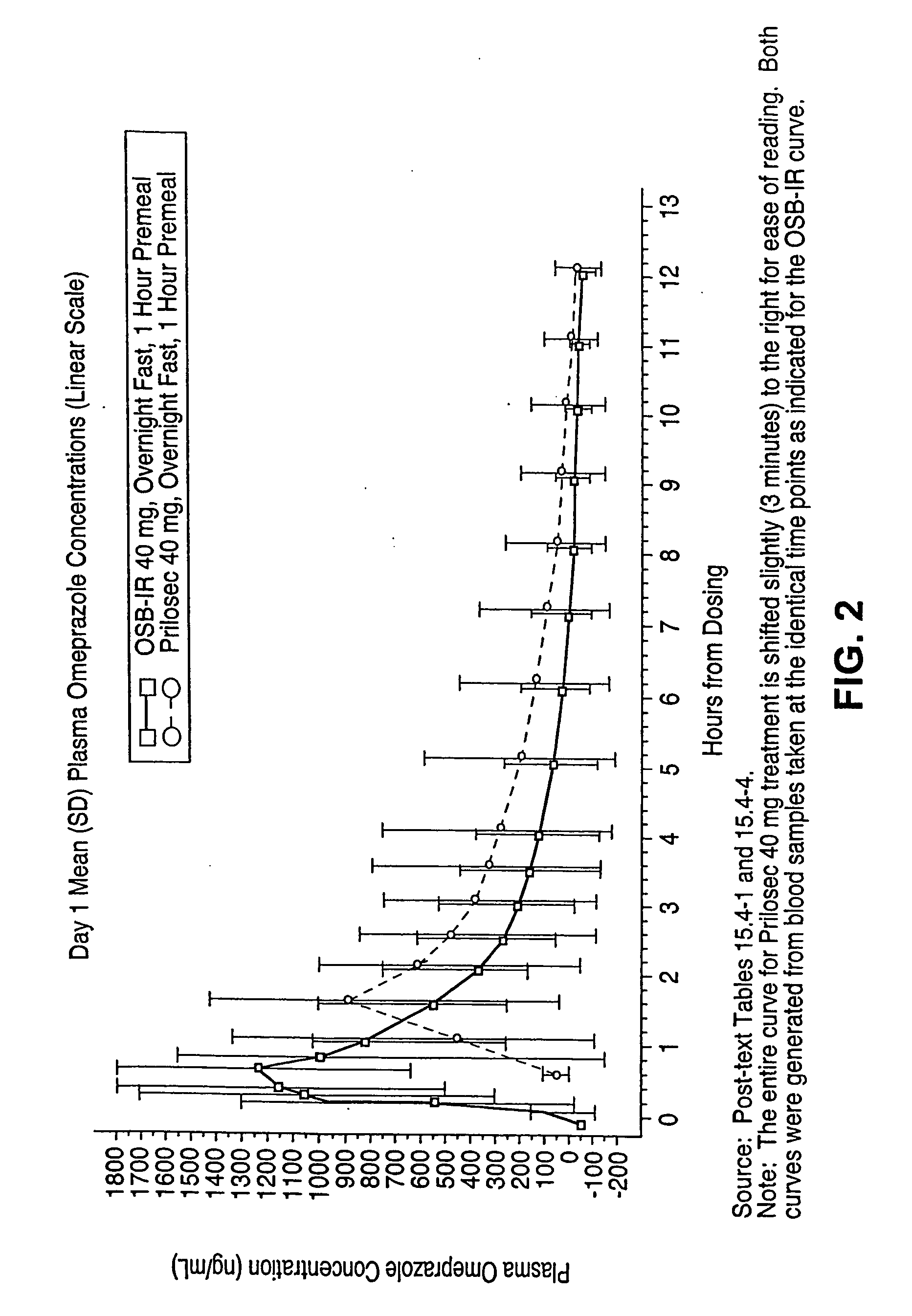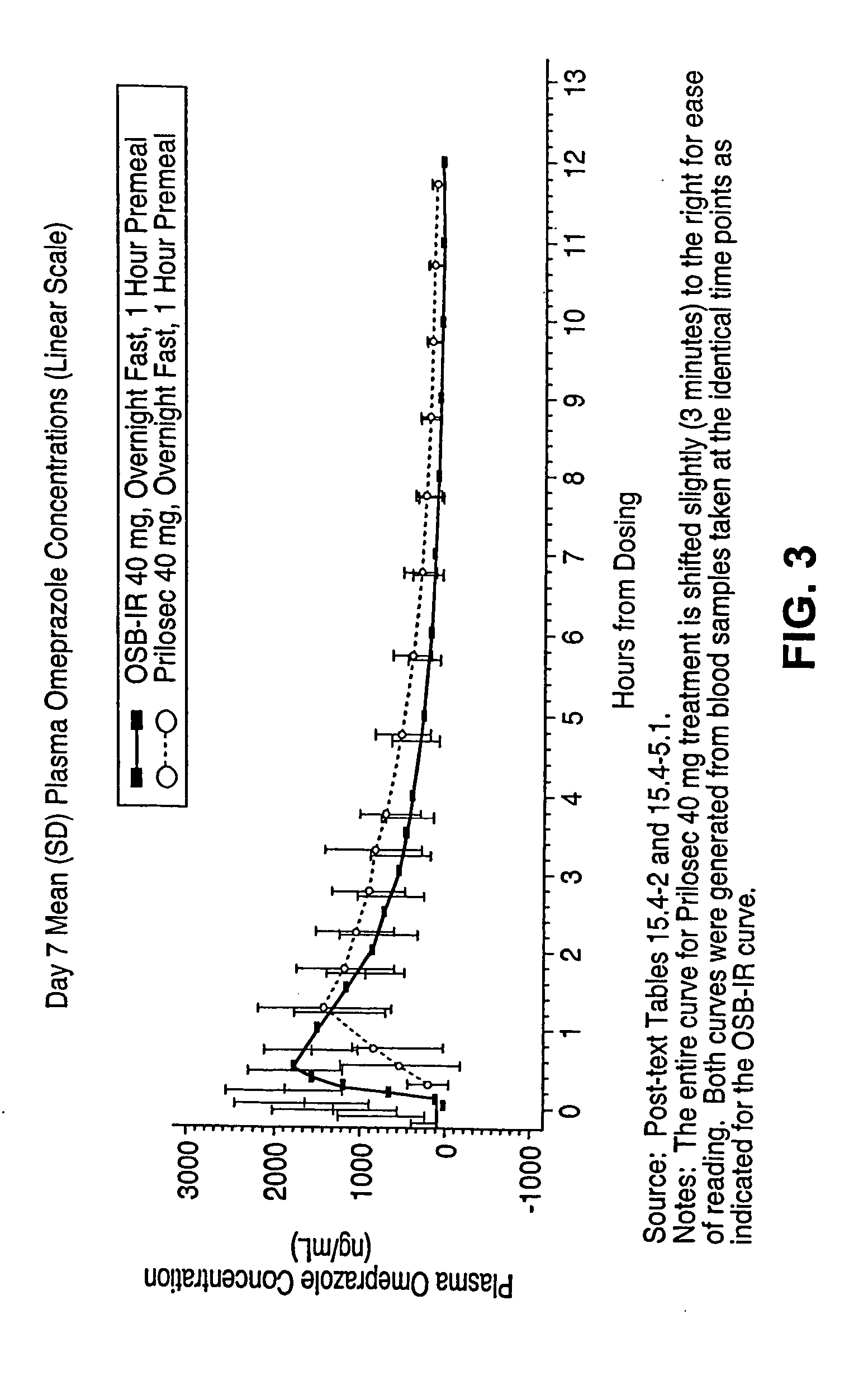Novel formulation, omeprazole antacid complex-immediate release for rapid and sustained suppression of gastric acid
a proton pump inhibitor and complex technology, applied in the direction of dispersed delivery, drug compositions, organic non-active ingredients, etc., can solve the problems of significant upper gastrointestinal bleeding, adverse side effects, and inability to completely treat, so as to reduce the production of gastric acid, inhibit or reduce degradation, and reduce or inhibit one or more symptoms.
- Summary
- Abstract
- Description
- Claims
- Application Information
AI Technical Summary
Benefits of technology
Problems solved by technology
Method used
Image
Examples
example 1
Abbreviations, Standards, and Reagent Sources
[0278] This example describes abbreviations, standards, reagent sources, and various pharmacokinetic and pharmacodynamic parameters disclosed herein.
[0279] SAN-05 / OSB-IR (powder for suspension): Omeprazole (20 mg or 40 mg) with sodium bicarbonate 1680 mg (20 mEq), for immediate-release, reconstituted to a total volume of 20 mL of water at 1 or 2 mg / mL.
[0280] SAN-10 / OME-IR (capsule): Omeprazole (20 mg or 40 mg) with an antacid complex, for immediate-release. Antacid complexes included: sodium bicarbonate alone; sodium bicarbonate with magnesium hydroxide; and sodium bicarbonate with calcium carbonate.
[0281] SAN-15 / OME-IR (chewable tablet): Omeprazole (20 mg or 40 mg) with an antacid complex, for immediate-release. Antacid complexes included: sodium bicarbonate alone; sodium bicarbonate with magnesium hydroxide; and sodium bicarbonate with calcium carbonate.
[0282] OME-DR (enteric-coated): Omeprazole (20 mg or 40 mg) with enteric-coatin...
example 2
Trial Protocols
[0313] This example describes several trial protocols used to obtain results described herein.
SAN-15-C01 Trial Protocol
[0314] This trial protocol is designed as a single-dose crossover study, wherein each subject received one or two chewable antacid tablets administered concomitantly with omeprazole powder during each treatment period, for up to six treatment periods. Each period was followed by a 7-14 day washout. The same treatment was administered to all subjects in each trial period:
[0315] Period 1: One (1) antacid tablet (formulation 1:3) plus 40 mg omeprazole powder administered in the fasted state.
[0316] Period 2: 20 mEq sodium bicarbonate plus 40 mg omeprazole powder as an aqueous suspension administered in the fasted state.
[0317] Period 3: Prilosec 40 mg delayed-release capsule administered in the fasted state.
[0318] Period 4: One (1) antacid tablet (formuation 1:3) plus 40 mg omeprazole powder administered 1 hour after initiating a meal.
[0319] Perio...
example 3
Omeprazole is Well Absorbed and Rapidly Absorbed in the Presence of Antacid
[0365] This example describes results indicating that omeprazole is well absorbed in the presence of antacid, and that a single oral dose of omeprazole antacid complex is rapidly absorbed (see example 8 for the effects of omeprazole antacid complex on gastric acidity). To compare the pharmacokinetic characteristics of omeprazole plus antacid-immediate release to those of omeprazole alone, studies were performed as described in the OSB-IR-CO1C trial protocol.
[0366] The pharmacokinetic profiles of omeprazole powder plus chewable antacid tablets, omeprazole powder alone, Prilosec® capsules (omeprazole), and Nexium® capsules (esomeprazole magnesium) in the context of different dosing regimens relative to the ingestion of meals were performed as described in the SAN-15-CO1C trial protocol.
[0367] These results from trial SAN-15-CO1C, summarized in Table 3.A).
TABLE 3.APharmacokinetics of Omeprazole Powder (40 m...
PUM
| Property | Measurement | Unit |
|---|---|---|
| Fraction | aaaaa | aaaaa |
| Fraction | aaaaa | aaaaa |
| Fraction | aaaaa | aaaaa |
Abstract
Description
Claims
Application Information
 Login to View More
Login to View More - R&D
- Intellectual Property
- Life Sciences
- Materials
- Tech Scout
- Unparalleled Data Quality
- Higher Quality Content
- 60% Fewer Hallucinations
Browse by: Latest US Patents, China's latest patents, Technical Efficacy Thesaurus, Application Domain, Technology Topic, Popular Technical Reports.
© 2025 PatSnap. All rights reserved.Legal|Privacy policy|Modern Slavery Act Transparency Statement|Sitemap|About US| Contact US: help@patsnap.com



